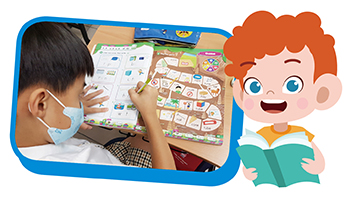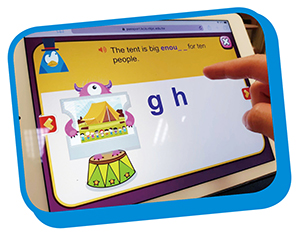
Connecting Phonics to Spelling and Reading
國際處主任 賴國宜
There are many differences between Chinese and English which means the methods of learning English are very different from learning Chinese. One of the major differences is phonics. All English words are made from the 26 letters. Therefore, if a learner can understand the relationship between letters and sounds, they will be able to spell, read and write most English words. In Ms. Pennell's article, she explains that besides teaching phonics rules, it's also crucial to help students develop phonemic awareness, which is the ability to hear and manipulate sounds in spoken words. Then students can apply these skills to spelling, reading and writing.
從語言學習的理論來看,第二語言的學習困難度,取決於它跟學習者「母語」的差異。中文和英文是兩種南轅北轍的語言,對初學者而言,最大的差異在拼寫,中文是表意的象形文字,英文是拼音文字,所有的詞彙皆由26個字母組合,因此,初學者如能掌握字母和語音之間的對應關係,就能「聽音拼字、看字會讀」。在康橋,一到三年級都有安排phonics課程,除了教授字母拼讀規則,更關鍵的是,讓學生將規則內化成為閱讀和寫作的基本技能。希望Ms. Pennell的文章,能幫助家長更了解外師如何幫助學生發展聲韻覺識(phonemic awareness),並引導他們將字母拼讀規則運用到實際的單字拼音和讀寫練習。
如果英語村的飯店增設房間,午休時可以利用賺來的康橋幣去飯店休息。圖書館應該增設更多辦理借書的地方,下課時就不會大排長龍。您覺得這些建議有道理嗎?四年級正在進行「探索康橋校園」專題,孩子們以自身的經驗為例,分享學校各個學習場域的特色與功能,並提出能讓這些場域更好的建議,透過他們的專題報告,您將了解更多孩子們在學校的多元學習活動。
熱熱鬧鬧的校慶活動已結束,期中評量隨著登場,希望孩子們都能靜下心為這段期間的學習做個整理,祝大家考試順利。

~ Eliza Pennell
English Teacher, International Department
Our first, second, and third graders work hard to master phonics. Learning phonics is a critical step in learning English, so we have built a curriculum in which students will build up their phonics skills over their first three years at Kang Chiao. In this article, we will talk about phonics and how it relates to reading, spelling, and speaking.
Sights and Sounds
There are many differences between studying Chinese and English, as well as differences between studying one’s native language and a second language. Phonics is an example of one of these differences. When learning English, students need to understand the relationship between a letter, the sound it makes, and how it works with other letters. Understanding this relationship is the most basic step students must take in order to understand how English works. It is especially important for our students because it is so different from the way they learn Chinese.

Each week, when students learn new vocabulary words in English class, we use these words to reinforce phonemic awareness. Teachers lead students through blending the letters’ phonemes. For example, when teachers present the vocabulary term “twin,” they demonstrate how to blend the phonemes /t/ - /w/ - /I/ - /n/ - in order to read the word.
Breaking English words into their phonemes like this is critical for non-native speakers. Children need to master the basic phonics of words as they read them. Therefore, we focus on phonics throughout the first three years at Kang Chiao.
Sound It Out!
It’s not uncommon to hear our teachers respond to students asking, “How do you spell this word?” by saying, “Sound it out!” In this way, teachers encourage students to practice their phonics skills. Using phonemic awareness to spell words allows students to notice patterns and apply these patterns to similar words. For example, students who can sound out /k/ - /a/ - /t/ - “cat” – will notice similar sounds in “mat” - /m/ - /a/ - /t/, “rat”, “bat”, and so on.

By requiring students to think about the sounds they hear when they spell a word, we are ensuring that students have constant practice recalling the sounds of English. Practicing in this manner leads students towards automatic reading. They no longer need to think about the individual letters or sounds in a word to understand it.
Phonics also leads to more accurate pronunciation. Our students speak English with native-like accents. By the end of third grade, we do not need to do pronunciation drills or practice basic speaking skills. It’s all thanks to studying phonics at an early age.
Bolder, More Independent Learners

Phonics is among the most basic elements of studying language. Mastering it provides the tools students need to continue learning English efficiently. Many schools skip teaching phonics, or they fail to emphasize it enough for students to reach mastery. At KCIS, we know the importance of phonics.
Giving students tools to read and spell new words will encourage them to think of their learning as a constant process. English does not consist simply of words they “know” and words they “don’t know.” Each word can be decoded using phonics. Once students are able to use these tools to their advantage, they become more independent in their reading and writing, as well as more willing to face new academic challenges.

![]() 全文下載)
全文下載)